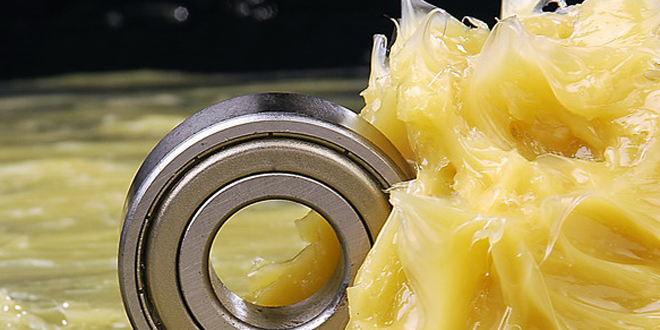
Description of grease
RAHA Oil Co is one of the leading manufactures of grease and currently exporting goods to Europe, Africa and Asia. Grease is essentially a suspension of oil in a thickening agent, along with appropriate additives. The oil generally makes up between 75 and 90% of the weight of a grease, and it is held in place by the gel structure of the thickener to carry out its lubricating function.
Grease is a semisolid lubricant. Grease generally consists of a soap emulsified with mineral or vegetable oil. The characteristic feature of greases is that they possess a high initial viscosity, which upon the application of shear, drops to give the effect of an oil-lubricated bearing of approximately the same viscosity as the base oil used in the grease. This change in viscosity is called shear thinning.
Grease is sometimes used to describe lubricating materials that are simply soft solids or high viscosity liquids, but these materials do not exhibit the shear-thinning properties characteristic of the classical grease. For example, petroleum jellies such as Vaseline are not generally classified as greases.
Greases are applied to mechanisms that can only be lubricated infrequently and where a lubricating oil would not stay in position. They also act as sealants to prevent ingress of water and in-compressible materials. Grease-lubricated bearings have greater frictional characteristics due to their high viscosity.
Uses of Grease
Lubrication: grease versus oil, The choice between grease lubrication and oil lubrication is chiefly determined by the following factors:
- Grease should be used in applications where the following requirements apply:
— Simplified maintenance
— Improved cleanliness (fewer leaks)
— Better protection against contaminants
- Oil lubrication should be used in applications where normal operating temperatures are high as a result of an external heat source or excess heat generated by the machine or its bearings at high speed.
Suitable applications for grease
Grease and oil are not interchangeable. Grease is used when it is not practical or convenient to use oil. The lubricant choice for a specific application is determined by matching the machinery design and operating conditions with desired lubricant characteristics. Grease is generally used for:
- Machinery that runs intermittently or is in storage for an extended period of time. Because grease remains in place.
- Machinery that is not easily accessible for frequent lubrication. High-quality greases can lubricate isolated or relatively inaccessible components for extended periods of time without frequent replenishing. These greases are also used in sealed-for-life applications such as some electrical motors and gearboxes.
- Machinery operating under extreme conditions such as high temperatures and pressures, shock loads, or slow speed under heavy load. Under these circumstances, grease provides thicker film cushions that are required to protect and adequately lubricate, whereas oil films can be too thin and can rupture.
- Worn components Grease maintains thicker films in clearances enlarged by wear and can extend the life of worn parts that were previously oil lubricated. Thicker grease films also provide noise insulation.
The difference between grease & oil
Grease and oil are both common lubricants used in bearings. The main difference between grease and oil is that grease consists of an oil and a thickener. The thickener acts like a sponge that retains the oil. Grease can also contain various additives such as rust inhibitors, EP (extreme pressure) additives, oxidation preventatives, etc. Typically greases will have a semi-solid to solid consistency. This consistency allows grease to stay in place longer than oil. For many applications, the ability to stay in place and slowly release oil gives grease an advantage over oil alone.
What are Grease Types?
Grease is classified into two main soap and non-soap groups, based on the type of thickener:
- Soap based grease
This grease is divided to three groups as below:
- Simple soap grease
This grease is made of base oil and a metal soap which is a product of a fatty acid and a metal hydroxide such as aluminum, sodium, calcium, lithium or barium reaction and neutralization.
- Mixed soap grease
This grease is made of base oil and a mixture of two different metal soaps such as lithium and calcium soaps.
- Complex soap grease
This grease was developed to improve the heat resistance of soap based greases. It is similar to regular soap grease except that its thickener is consisted of two dissimilar acids one fatty and one organic. This grease has higher dropping point and better resistance under high loads, temperatures and speeds. The most popular complex soap greases are aluminum, lithium, calcium, and barium complex greases.
- Non-Soap based grease
This grease is divided to two groups as below:
- Mineral based grease
This grease is made of base oil and a mineral thickener such as mineral clay like bentonite, modified mineral silicate or graphite.
- Polymer based grease
Examples of this grease are poly urea grease and thermoplastic powders grease.

